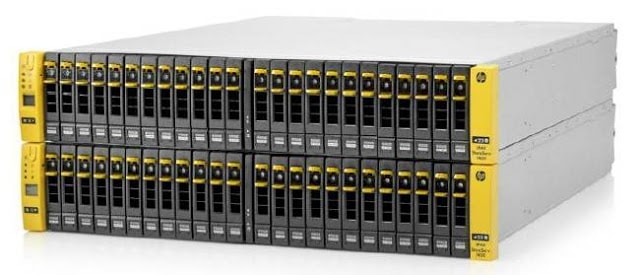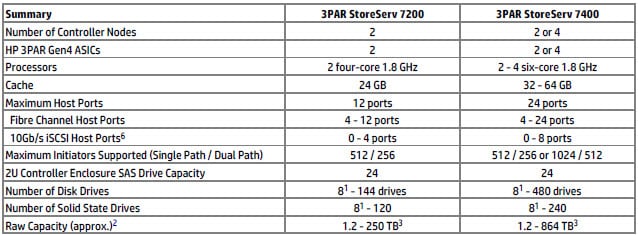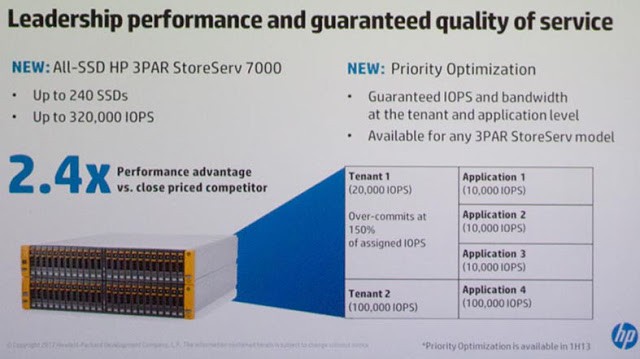This week in Frankfurt HP is hosting Discover 2012, where they’ve unveiled some big product announcements. The big news is the birth of the 3PAR 7200 and 7400 arrays, a new line of hardware which drastically pushes down the price point for 3PAR storage firmly into the mid-range. HP is clearly targeting customers that are looking at EMC VNX 5000s, NetApp FAS3200s, Dell Compellent, and other arrays at that price point.
You now have a single architecture, same set of tier-1 tools, from the mid-range to the high end. Bare bones configurations start at $20K for the 2-controller model. As always, HP’s Calvin Zito and fellow vExpert, has written up a short article about the new 3PAR P7000 series, and has a couple of videos to boot. You can check out his post here. The full HP announcement page is here.
But for those of you unfamiliar with 3PAR, I’ve give you a quick overview. 3PAR was a silicon valley startup which specialized in tier-1 block storage with a unique way of wide striping LUNs across all disks in your array. The founders were SUN refugees. A couple of years ago HP bought them (in a bidding war with Dell) to augment their aging EVA line, and give them an in-house tier-1 array.
The secret 3PAR sauce are “chunklets” of data which are the building blocks of virtualizing the storage and use several layers of abstraction so you no longer manage RAID sets, spindles, or spare disks that sit idle. LUNs are chopped up and evenly distributed across your entire array, in an even manner, automatically balancing I/O across all controllers and disk ports. Another key feature of the secret sauce is their proprietary 3PAR ASIC (now at Gen4) which offloads RAID calculations, zero detection, and other work off the Intel processors.
The high end model (StorServ 10800) can scale up to 8 controllers, and all have a true active/active concurrent controller architecture, not asymmetric active/active like the vast majority of mid-range arrays. 3PAR competed with EMC Symmetrix and HDS USP, which both have active/active concurrent designs. This improves I/O throughput and automates load balancing between controllers. For a geeky overview of all the 3PAR “secrets” check out the 3PAR InForm OS concepts guide here.
At VMworld 2011 HP announced the 3PAR 10000 series, which included the V400 (four-controller) and V800 (eight-controllers). However, if you needed a tier-1 disk array for under $100K, then you were left looking elsewhere or stuffing your piggy bank with dough to spring for a V400 sometime in the future.
The two new models are the 3PAR 7200 (dual controllers), and the 3PAR 7400 (quad controllers). The 3PAR 7200 is a very compact 2U, and holds 24 2.5″ drives, with expansion up to 144 disks with more shelves. The 7400 is pictured at the top of this article, and more than doubles the capacity up to 480 drives and 864TB raw storage. You can view the full Quickspecs PDF here. With an upcoming upgrade to the InForm OS, it will also support FCoE on the optional CNAs or iSCSI (today).
Being familiar with 3PAR, I wondered what they were going to do about the service processor in the P7000 series. Basically the service processor is a 1U appliance, which didn’t sit in the data path or control the data flow, but was used for monitoring and remote servicing. Guess what? That is now virtualized, and is packaged to run on vSphere 4.1, 5.0 or 5.1. Hyper-V support is coming in 2013. That’s pretty cool! You can still buy a hardware version of the SP, if you wish.
Reading through the 3PAR Software Products PDF, found here, I stumbled across some new features as well. “Persistent Ports” is a tier-1 data resiliency feature that allows non-disruptive software updates of the array, without requiring host multi-pathing software. Even if you have multi-pathing software, this enables faster/seamless fail-over since some multi-pathing software can take 10s of seconds to reconfigure. Basically controller node WWNs are shadowed on another node, through the use of NPIV, and can nearly instantly migrate so that the host doesn’t realize a node went offline.
Another new feature, which probably won’t be used by end users, is the addition of a REST-compliant Web Services API. Hopefully it will be used by VARs for better integration/management of 3PAR. Autonomic rebalance, which enables the array to non-disruptively re-distribute data across the array when new hardware is added, has been added. Also, for Windows Server 2012 Hyper-V customers, the 3.1.2 release of InForm OS will support ODX offload, which is Microsoft’s version of VMware VAAI with added goodies like space reclamation.
One good aspect of the HP acquisition of 3PAR, is the incorporation of easy setup tools that EVA customers may be used to using. HP also announced a migration path from EVA to 3PAR, that they say is even easier than migrating from one EVA to another EVA. Online data migration, and automatic thin-conversion! Unlike the big brother 10000 series, the P7000 models are self-install and have simple EVA-like initial setup. No professional services needed to get your P7000 up and running!
Ok, so what if you buy a P7200 today, and you have a storage explosion and need more space or even more host facing ports? 3PAR has “peer motion” which allows you to non-disruptively move LUNs to a new 3PAR array, such as a P10000. You would use the same management tools, and your servers wouldn’t even know the migration took place. Pretty cool!
Finally, another new feature due out in 1H 2013 is Priority Optimization. As shown in the HP slide below, you can guarantee IOPS and bandwidth at the tenant and application level. In multi-tenant environments, or where storage is shared between environment such as production and test/dev, this could be a great feature.
Although not featured in great detail, HP is also releasing a Windows Server 2012 NAS front-end for 3PAR, which provides CIFS and NFS shares with data de-duplication. Microsoft has totally re-written their CIFS and NFS stacks to provide multi-10Gb speeds, and enhanced security like CIFS encryption. So don’t hold your nose at HP using Windows Server 2012, as it’s a huge departure from previous versions. Plus, you won’t have the potential integration hiccups of a third-party NAS device in Microsoft-centric environments that require high security.
In short, this is a great announcement and a big win for customers. EVA customers can finally get modern highly virtualized storage at a great price point, customers can non-disruptively migrate to the P10000s, and existing P10000 customers could use a P7x00 as a DR/BC target for cost effective storage.
As good as the 3PAR hardware is, HP could really invest a lot into an extreme make-over of their System Reporter (SR) and Recovery Manager for VMware products. EMC and other vendors have a leg up in this area, that would not take a great deal of money for HP to close up the gap. Thankfully the IMC, which you use to manage and provision storage on 3PAR, is extremely friendly to use and doesn’t suffer from the same issues as the other two software products. For SMB customers I think getting brand-new SR and Recovery Manager releases will be key for smooth adoption and good user experience.









Great summary as always Derek. I would like to add 2 things.The 3PAR line offers Write Caching like many other arrays, but if you drop down to only 1 node, the write caching is disabled and the array is put in write-through mode to avoid data loss should the lone controller go down. In a 7200, this means any time you need to bounce a controller for online maintenance you will take a performance hit. This is very common in 2 node based arrays and not unique to 3Par. The 7400 would allow you to take 1 node offline and… Read more »
@DAN: Thanks for the feedback! Yes you are very correct about the 4 and 8 node (on the 10800) being able to maintain write cache when one controller is offline. This is a great advantage of the multi-node 3PAR architecture. Nice to hear HP has done some integration with the WS2012 storage gateway. Ultimately, for a seamless experience, either the IMC needs full NAS integration (e.g. another pane), or on the WS2012 Gateway it needs a fully integrated IMC/File Server GUI so you can do everything in one pane like the NAS competition. I saw a public HP document that… Read more »
Great summary if it is true. Active/Active……Last thing I read from HP directly is the following from the HP 3PAR Architecture Guide“An LD has an “owner” and a “backup owner”. The owner is the Controller Node that under normal circumstances performs all operations on the LD. If the owner fails, the backup owner takes over ownership of the LD. The owner sends sufficient log information to the backup owner so that the backup owner can take over without loss of data.The chunklets used in an LD are preferably chosen from PDs for which the owner and backup owner are connected… Read more »
@Anonymous: You are confusing two very different aspects of the storage array and drawing an incorrect conslusion. One aspect is how the array writes to the physical disk, which is quite different from how it handles vLUNS which is what the host sees. Per 3PAR:“Unlike legacy “active-active” controller architectures—where each LUN (or volume) is active on only a single controller—this Mesh-Active design allows each LUN to be active on every mesh controller in the system. This design delivers robust, load-balanced performance and greater headroom for cost-effective scalability, overcoming the tradeoffs typically associated with modular and monolithic storage. The high-speed, full-mesh,… Read more »